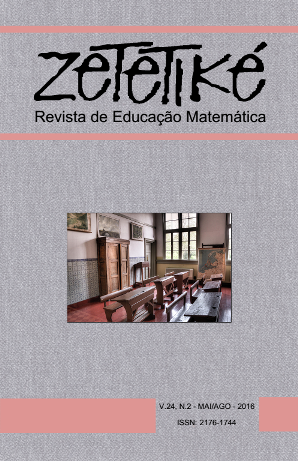Resumo
Neste artigo, refletimos como professores que ensinam matemática constroem justificações geométricas usando relações e propriedades e como esses resolvem uma tarefa sobre quadriláteros e suas bissetrizes no ambiente VMTcG. Os professores são participantes do projeto de formação continuada com tecnologias digitais, trabalham em pequenas equipes colaborativamente para construir figuras geométricas e resolver problemas geométricos. Dada uma sequência de tarefas elaboradas para colaboração em um ambiente virtual colaborativo, analisamos como três professores colaborativamente e discursivamente construíram justificações dedutivas com base em suas próprias conjecturas e percepções de relações entre objetos geométricos, sem o uso de medidas. Esse resultado e as condições em que ele foi realizado geram implicações para a Educação Matemática de professores e para a prática docente deles.
Referências
ALAGIC, G., & ALAGIC, M. (2013). Collaborative mathematics learning in online environments. In D. Martinovic, V. Freiman, & Z. Karadag (Eds.), Visual Mathematics and Cyberlearning (Vol. 1, pp. 23-48). New York: Springer.
AMARAL, R. B. (2011). Argumentação matemática colaborativa em um ambiente online. Acta Scientiae, 13(1), 55-70. Retirado em 12 de novembro de 2013, de http://www.periodicos.ulbra.br/index.php/acta/article/view/23/20.
ARZARELLO, F., Olivero, F., Paola, D., & Robutti, O. (2002). A cognitive analysis of dragging practises in Cabri environments. International Reviews on Mathematical Education (ZDM), 34(3), 66-72.
CHRISTOU, C., Mousoulides, N., Pittalis, M., & Pitta-Pantazi, D. (2004). Proofs through exploration in dynamic geometry environment. International Journal of Science and Mathematics Education, 2(3), 339-352.
GATTEGNO, C. (1987). The science of education: Part 1: Theoretical considerations. New York: Educational Solutions.
HÖLZL, R. (2001). Using dynamic geometry software to add contrast to geometric situations – A case study. International Journal of Computers for Mathematical Learning, 6(1), 63-86.
MISHRA, P., & Koehler, M. J. (2006). Technological pedagogical content knowledge: A framework for teacher knowledge. Teachers College Record, 108(6), 1017-1054.
ÖNER, D. (2008). Supporting students’ participation in authentic proof activities in computer supported collaborative learning (CSCL) environments. Computer-Supported Collaborative Learning, 3, 343-359.
POWELL, A. B. (2014). Construção colaborativa do conhecimento tecnológico, pedagógico e do conteúdo de professores de matemática. Boletim GEPEM, 64, 88-103.
POWELL, A. B., & Alqahtani, M. M. (2015). Tasks and meta-tasks to promote productive mathematical discourse in collaborative digital environments. In I. Sahin, S, A. Kiray, & S. Alan (Eds.), Proceedings of the International Conference on Education in Mathematics, Science & Technology (pp. 84-94). Antalya, Turkey.
POWELL, A. B., Borge, I. C., Floriti, G. I., Kondratieva, M., Koublanova, E., & Sukthankar, N. (2009). Challenging tasks and mathematics learning. In E. J. Barbeau, & P. J. Taylor (Eds.), Challenging mathematics in and beyond the classroom: The 16th ICMI study (pp. 133-170). New York: Springer.
POWELL, A. B., & Grisi-Dicker, L. (2012). Toward collaborative, discourse-focused learning with dynamic geometry environment. In Proceedings of the 12th International Congress on Mathematical Education (pp. 1-10). Seoul, Korea: ICME.
POWELL, A. B. & Lai, F. F. (2009) Inscriptions, mathematical ideas, and reasoning in VMT. In G. Stahl (Ed.), Studying virtual math teams. (ch 13, pp. 237-259). New York, NY: Springer.
SFARD, A. (2000). Symbolizing mathematical reality into being. Or how mathematical discourse and mathematical objects create each other. In P. Cobb, E. Yackel, & K. McClain (Eds.), Symbolizing and communicating in mathematics classrooms: Perspectives on discourse, tools, and instructional design (pp. 37-98). Mahwah, NJ: Lawrence Erlbaum Associates.
SILVERMAN, J. (2011). Supporting the development of mathematical knowledge for teaching through online asynchronous collaboration. The Journal of Computers in Mathematics and Science Teaching, 30, 61-78.
STAHL, G. (Ed.). (2009). Studying virtual math teams. New York: Springer.
STAHL, G., Koschmann, T., & Suthers, D. (2008). Aprendizagem colaborativa com suporte computacional: Uma perspectiva histórica. Boletim GEPEM, 53, 11-42.

Este trabalho está licenciado sob uma licença Creative Commons Attribution-NonCommercial-NoDerivatives 4.0 International License.
Copyright (c) 2016 Zetetiké: Revista de Educação Matemática

